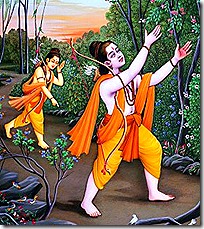 “The monkey became numb for a second, stricken as he was with sadness over not having found, after such a long time, Sita, the wife of Rama - the lord of men and the best among those who can speak.” (Valmiki Ramayana, Sundara Kand, 5.27) “The monkey became numb for a second, stricken as he was with sadness over not having found, after such a long time, Sita, the wife of Rama - the lord of men and the best among those who can speak.” (Valmiki Ramayana, Sundara Kand, 5.27)
sītāmapaśyan manujeśvarasya |
rāmasya patnīm vadatām varasya | babhūva duḥkhābhihataścirasya | plavaṅgamo manda ivācirasya ||
It’s strange to think that even Shri Hanuman, one of the most celebrated worshipable figures in the world, gets down on himself every now and then. If the hero Hanuman, who is full of courage, valor, strength, perseverance, fortitude, clarity of vision, and complete knowledge, can feel sadness over not achieving his objectives in a reasonable amount of time, what then to speak of others? Hanuman’s exalted stature shows that the key to advancing in consciousness is not necessarily to turn into a stoic robot, a person who completely lacks emotion and sits around like a stone. The trees already have this ability, and their duration of life is far longer than ours. They don’t require magic pills or ninety day diets to maintain their health; by nature’s grace they are allowed to remain in the same position for many, many years. The benefit of the human form of life is to be able to hear about wonderful people like Hanuman, honor them, and then learn from their example. How Hanuman handles his temporary dejection is what counts most. Based on the success he would see in his most difficult mission, it is to be understood that even his sadness is beneficial, as it strengthens his resolve.
 Why did Hanuman need to be strong? What was he ever sad about? Ravana, the king of the Rakshasas living in Lanka many thousands of years ago, had taken away a beautiful princess through a backhanded plot and brought her back to his kingdom. The princess named Sita Devi was already married at the time, but if kings would have a fair fight, sometimes the control over the princesses would change hands. Sita’s husband, however, was the greatest bow warrior the world had ever seen. He had previously dispatched 14,000 members of Ravana’s army to the abode of Yamaraja, the god of death. Living peacefully in the forest of Dandaka, Lord Rama, an incarnation of the Supreme Lord, did not bother anyone. He, His wife Sita, and His younger brother Lakshmana lived an austere lifestyle and were waiting for fourteen years to pass so that they could return to Rama’s kingdom of Ayodhya. Why did Hanuman need to be strong? What was he ever sad about? Ravana, the king of the Rakshasas living in Lanka many thousands of years ago, had taken away a beautiful princess through a backhanded plot and brought her back to his kingdom. The princess named Sita Devi was already married at the time, but if kings would have a fair fight, sometimes the control over the princesses would change hands. Sita’s husband, however, was the greatest bow warrior the world had ever seen. He had previously dispatched 14,000 members of Ravana’s army to the abode of Yamaraja, the god of death. Living peacefully in the forest of Dandaka, Lord Rama, an incarnation of the Supreme Lord, did not bother anyone. He, His wife Sita, and His younger brother Lakshmana lived an austere lifestyle and were waiting for fourteen years to pass so that they could return to Rama’s kingdom of Ayodhya.
Ravana was so desperate to have Sita that he cast aside proper protocol. He avoided confrontation with Rama because he knew he would lose. Setting up a ruse that temporarily lured Rama and Lakshmana away from the group’s camp, Ravana swooped in wearing a disguise and then forcibly took Sita with him. When Rama returned to see that Sita was missing, He immediately fell into grief. How can God lament? In the Vedic tradition, the shudras are known especially for being easily prone to lamentation. And what do they despair over? Anything relating to the body, the temporary covering of the spiritual spark, the essence of life, is the cause of distress. In this respect the proclivity towards lamentation isn’t exclusive to a specific class determined on quality or work; sadness attacks any flawed consciousness. Lamenting over losses in gambling, sports, stocks, or other areas not related to the plight of the soul is not very intelligent. Even lamenting over death, which is nothing more than the changing of bodies for the soul, indicates a lack of intelligence.
Lord Rama, as the Supreme Personality of Godhead, surely knew the differences between matter and spirit and how only the less intelligent lament over things not worthy of attention. When His father, Maharaja Dasharatha, had ordered Him to leave the kingdom on the eve of His would-be coronation, Rama did not bat an eye. When He was further instructed to renounce ties to the kingdom and assume the garb of an ascetic, Rama was more concerned about ensuring that His father’s word was honored. Rama proved Himself to be atmarama, or self-satisfied, on many occasions.
 Was His lamentation over Sita’s abduction a sign of weakness? Was Rama too attached to His wife, a person whose association is only temporary after all? Those things that we know to be detrimental, along with the forces of temporary change, such as time, space, matter, attachment, anger, greed, lust, envy, pride, etc., are actually only harmful when they keep one away from their constitutional position. As Lord Chaitanya so nicely states, the living entity’s original form is that of a devotee of Krishna, which is another name for God. When this position is understood, every activity and event in life can be properly assessed. God is the object of all virtue, piety and systems of practice. Therefore He is not affected by any temporary ups and downs or changes in time. He is the very person whose association is lost when the effects of the material world take hold of the living entity’s consciousness. Was His lamentation over Sita’s abduction a sign of weakness? Was Rama too attached to His wife, a person whose association is only temporary after all? Those things that we know to be detrimental, along with the forces of temporary change, such as time, space, matter, attachment, anger, greed, lust, envy, pride, etc., are actually only harmful when they keep one away from their constitutional position. As Lord Chaitanya so nicely states, the living entity’s original form is that of a devotee of Krishna, which is another name for God. When this position is understood, every activity and event in life can be properly assessed. God is the object of all virtue, piety and systems of practice. Therefore He is not affected by any temporary ups and downs or changes in time. He is the very person whose association is lost when the effects of the material world take hold of the living entity’s consciousness.
Rama’s love for Sita cannot be duplicated. How then could He not lament over her absence? Love should mean something. The bond Sita and Rama share transcends the temporary world and its influence. Sita and Rama reside eternally in the spiritual sky, so their link is never broken. Acting out dramatic roles on earth for the benefit of others, Sita and Rama sometimes were not together, but their thoughts never deviated from each other’s interests.
If Rama had lamented to the point that He gave up on finding Sita, then it would have set a bad example for others. Instead, He used His outward display of grief to forge ahead and work tirelessly towards rescuing His wife. This determination was also passed on to those who came to help Him, the Vanaras residing in the Kishkindha forest. Hanuman was their most capable warrior, and he also happened to be the most devoted to Rama. Upon first meeting the Lord and Lakshmana, Hanuman knew that they were something special. He wasn’t after self-realization or self-aggrandizement; he just knew that Rama was the person he would spend the rest of his life trying to please. That is the recessed desire of every living being anyway, and with Hanuman it took over his entire existence. The devotee is surcharged with the motivation to please God, as this is the source of their pleasure as well.
 From Rama’s qualities, Hanuman could tell that the Lord was worthy of worship. Since Hanuman is keenly intelligent, he doesn’t get fooled by material opulence, word jugglery, or shows of magic that are rooted in mystic yoga. Hanuman can invoke any of the famous yogic siddhis, or perfections. He can become larger than the largest and smaller than the smallest, yet he never for a second thinks himself to be God. He knows that Bhagavan is the Supreme Personality, who possesses the attributes of beauty, wealth, strength, fame, renunciation and wisdom to the fullest degree and at the same time. From Rama’s qualities, Hanuman could tell that the Lord was worthy of worship. Since Hanuman is keenly intelligent, he doesn’t get fooled by material opulence, word jugglery, or shows of magic that are rooted in mystic yoga. Hanuman can invoke any of the famous yogic siddhis, or perfections. He can become larger than the largest and smaller than the smallest, yet he never for a second thinks himself to be God. He knows that Bhagavan is the Supreme Personality, who possesses the attributes of beauty, wealth, strength, fame, renunciation and wisdom to the fullest degree and at the same time.
Being able to properly identify Rama and His qualities, Hanuman took the mission of finding Sita very seriously. He was tasked with finding her and then returning the information of her location to Rama. The Lord would then march to wherever she was and take on her captor. Hanuman made it into Lanka, but he did not find Sita right away. Roaming the streets in the dark of night in a clandestine form, Hanuman saw so many different things, including beautiful women. They were dressed nicely and enjoying with their husbands, the Rakshasas. Yet he did not see Sita. After searching for so long, he momentarily became dejected.
Hanuman was directly engaged in God’s service, so how could he fall prey to lamentation? Shouldn’t he have been enthused at every second knowing that the Lord would help him in his search? The point to remember is that life’s influences that affect the non-devotee negatively don’t suddenly vanish once a person takes to devotional service, or bhakti-yoga. By regularly chanting, “Hare Krishna Hare Krishna, Krishna Krishna, Hare Hare, Hare Rama Hare Rama, Rama Rama, Hare Hare”, the laws of nature can’t be flaunted. Devotees still need to eat, sleep and take care of their bodies. They are still outwardly subject to the threefold miseries of life, those coming from nature, the body and mind, and other living entities.
 The difference with the bhaktas is how they react to these influences. As the aim of human life is to remain God conscious all the way up until the time of death, those who can withstand the inhibiting forces of material nature and maintain their link to the transcendental world will be successful in life’s mission. In Hanuman’s case, since he is so glorious the temporary bout of lamentation actually benefitted him. His reaction to his sadness could have cut two ways. He could have given up the mission and decided to return to Kishkindha. Along similar lines, he also could have just decided that he wasn’t worthy of living and then taken his own life. The difference with the bhaktas is how they react to these influences. As the aim of human life is to remain God conscious all the way up until the time of death, those who can withstand the inhibiting forces of material nature and maintain their link to the transcendental world will be successful in life’s mission. In Hanuman’s case, since he is so glorious the temporary bout of lamentation actually benefitted him. His reaction to his sadness could have cut two ways. He could have given up the mission and decided to return to Kishkindha. Along similar lines, he also could have just decided that he wasn’t worthy of living and then taken his own life.
Instead, he chose to forge ahead. He used his eagerness to see Sita to fuel his efforts. He searched more vehemently, this time going through the large palaces belonging to Ravana’s closest associates. He even made his way into Ravana’s palace, searching every inch of space. Not surprisingly, Hanuman would eventually succeed in his mission. His success could be attributed directly to his love for Rama. By understanding Rama’s divine qualities, Hanuman became familiar with Sita’s divine nature as well. He didn’t need it explained to him why she needed to be found. He didn’t have to have eagerness instilled in him; these things came automatically from his love for Rama.
For the sincere transcendentalist following Vedic instruction, which calls for austerity, penance, sacrifice and most importantly, dedication to the mission of purifying consciousness, troubles will always be encountered. Sometimes grievous errors will be committed and policies will be violated. While the turbulent waters of the material ocean of suffering are difficult to navigate, the life raft in the form of Shri Rama’s holy name and the examples set by His dear servants can help us to get across safely. Just remembering Hanuman, his beautiful form, his wonderful character, and his unmatched devotion to Sita and Rama is enough to put a smile on the face. If we are sad, down in the dumps, dejected over loss, lamenting over the cards dealt to us by nature, or simply having trouble moving forward in life, remembering Hanuman can never fail to be beneficial.
 Hanuman is forever dear to Sita and Rama, and it is not difficult to understand why. If someone were so devoted to us that they’d risk their life to keep us safe and happy, that they’d battle their own bouts of dejection to ensure that we wouldn’t feel any suffering, wouldn’t we be totally indebted to that person? Our parents offer us this protection and dedication in our youth; therefore it is not surprising that the Vedas advise that one’s first object of worship be the parents. Next comes the spiritual master, or guru, who acts as the father to guide the soul back to Godhead, to protect them on their journey home. Hanuman is forever dear to Sita and Rama, and it is not difficult to understand why. If someone were so devoted to us that they’d risk their life to keep us safe and happy, that they’d battle their own bouts of dejection to ensure that we wouldn’t feel any suffering, wouldn’t we be totally indebted to that person? Our parents offer us this protection and dedication in our youth; therefore it is not surprising that the Vedas advise that one’s first object of worship be the parents. Next comes the spiritual master, or guru, who acts as the father to guide the soul back to Godhead, to protect them on their journey home.
In this respect Hanuman can be thought of as a protector of devotional service, the topmost form of religious practice. Through his qualities and the example he sets, he allows anyone with a pure heart and untainted motives to learn how to please Sita and Rama. More than anything else, the way to gain their favor, the way to keep them always in our hearts, is to chant their names regularly. There can be no higher engagement than to be steadfastly devoted to hearing about and glorifying the Supreme Lord and His devotees. Through thick and thin, happiness and sadness, elation and misery, and the good times and the bad, if we follow the bhakti formula, our life’s journey will be as fruitful as Hanuman’s search through Lanka was.
In Closing:
Not finding Sita Hanuman met sadness,
To him city only had emptiness.
Hanuman, in the form of monkey did search,
Through city streets and on mountains’ perch.
Lord Rama, the most skilled of those who can speak,
Is the lord of men, God for everyone and each.
Enlisted help of Vanaras after Sita went missing,
His wife, for her Hanuman in Lanka went searching.
Grief bad for those who take identity that is wrong,
But not for those who know that to God they belong.
Hanuman’s sadness would only increase his perseverance,
For devotees, forces of nature no longer interference.
Remember Hanuman and his courage for your benefit,
God’s company you’ll get after current body you quit.
|
Science Daily — A Scripps Institution of Oceanography at UC San Diego-led research team followed the path of oxygen atoms on carbon dioxide molecules during photosynthesis to create a new way of measuring the efficiency of the world's plant life.